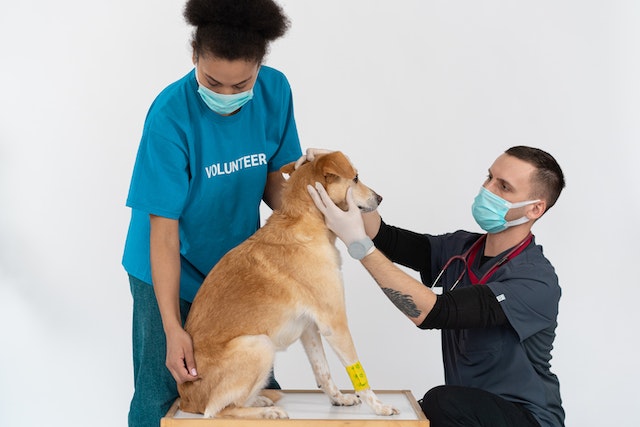Do Pugs Have a Lot of Health Problems

One of the most popular small dog breeds is the pug, which is adored for its soft features and vivacious nature.
But are there many health issues with these cute dogs?
The answer is yes, but you can make sure your Pug is healthy and content with the right care and a balanced diet.
Continue reading to find out more about typical Pug health issues and how to avoid them.
Do Pugs Have a Lot of Health Problems
Yes, Pugs are prone to a variety of health problems due to their brachycephalic (short-nosed) anatomy.
These include respiratory issues, eye problems, skin infections, and joint issues.
Pugs are also more likely to have certain genetic disorders, including hip dysplasia, and patellar luxation.
As a result, it is important to keep up with regular veterinary check-ups and screenings for your Pug.
Let’s break it down further…
Common Pug Health Problems
Here are some common pug health problems you should know:
Brachycephalic Obstructive Airway Syndrome (BOAS)
Several brachycephalic breeds, such as pugs, bulldogs, and boxers, are susceptible to the disease known as Brachycephalic Obstructive Airway Syndrome (BOAS).
It happens as a result of the airway channels narrowing, which can make breathing difficult.
Since that dogs with short muzzles are more likely to experience this illness, it may be hereditary in origin.
Furthermore, obesity might aggravate the BOAS symptoms, making it more difficult for the dog to breathe.
Maintaining a healthy weight, avoiding severe exercise, and using ethical breeding procedures are all part of prevention.
To help the dog breathe better in severe cases, surgery can be needed.
Eye Problems
Pugs are prone to a number of eye conditions, including cherry eye, dry eye, and corneal ulcers.
A foreign object can result in corneal ulcers, while insufficient tear production can result in dry eyes.
When the gland in the third eyelid prolapses, cherry eye results.
These problems can be uncomfortable and possibly impair vision. These issues may have environmental or genetic causes.
For early detection and effective treatment of eye issues, regular veterinary examinations are essential.
Also, it’s best not to breed dogs with known eye issues.
Skin Allergies
Pugs frequently experience skin allergies, which can be brought on by a number of things like food, pollen, dust mites, and flea bites.
A veterinarian may advise a diet of hypoallergenic food in the case of food allergies, which can be difficult to diagnose.
Skin allergies can be avoided via frequent flea prevention and avoidance of recognized allergens.
In order to maintain healthy skin and fur, proper grooming is also necessary.
Hip Dysplasia
Hip dysplasia is a disorder that results in pain and lameness because the hip joint does not grow properly. It may result from heredity, weight, or trauma.
Hip dysplasia can be avoided by ethical breeding procedures, which include checking prospective breeding dogs for the ailment.
It’s also crucial to maintain a healthy weight and refrain from the excessive effort.
Patellar Luxation
The disorder known as patellar luxation occurs when the kneecap falls out of place, resulting in pain and disability. It may be brought on by heredity or trauma.
This problem can be avoided by using proper breeding procedures, which include checking potential breeding dogs for patellar luxation.
It’s also crucial to maintain a healthy weight and refrain from the excessive effort.
Ear Infections
Pugs can develop ear infections because of their floppy ears, which can collect moisture.
Itching, odor, and discharge are symptoms. Regular ear cleaning and keeping the ears dry are necessary for prevention.
Also, keep the dog’s ears out of the water for long periods of time, such as during bathing or swimming.
Dental Problems
Pugs frequently experience dental issues, which can be inherited or brought on by neglecting oral care.
The prevention of dental issues can be aided by routine tooth brushing and dental examinations.
Furthermore, maintaining healthy teeth and gums can be aided by eating dry kibble as a diet and avoiding sweet treats.
Heart Problems
Pugs are prone to a number of heart issues, including mitral valve dysfunction and congestive heart failure.
Genetics or lifestyle choices, such as obesity or inactivity, might contribute to these problems.
Routine veterinary checks can identify heart issues early, enabling timely treatment.
Also, it’s best to refrain from breeding dogs who have heart conditions.
Obesity
Pugs are prone to obesity, which can cause diabetes, BOAS, hip dysplasia, and other health issues.
A good diet, avoiding overeating, and regular exercise are all important components of prevention.
It’s important to keep an eye on your pug’s weight and modify its diet and activity routine as necessary.
Pug Dog Encephalitis (PDE)
Pugs are susceptible to the uncommon, degenerative brain condition known as Pug Dog Encephalitis (PDE).
There is no known cure for it, and its cause is unknown.
Seizures, lack of coordination, and personality abnormalities are other symptoms.
PDE cannot be prevented, however, symptoms can be managed and the disease’s course can be slowed down with early detection and treatment.
MRI and spinal fluid studies are the usual methods for diagnosing PDE.
Heatstroke
Due to their sensitivity to heat, pugs can easily experience life-threatening heatstroke.
The dog should be kept in a cool area, given lots of water, and not allowed to exercise outside in the heat.
Pugs should be taken to a vet right away if they exhibit indications of heatstroke, including panting, drooling, or lethargy.
Digestive Issues
Pugs frequently have flatulence, constipation, and diarrhea due to digestive problems.
Dietary changes or underlying health conditions may be the root of these problems.
Consistency in feeding and avoiding foods that can upset the dog’s stomach are important components of prevention.
Early detection and treatment of digestive problems can be achieved with routine veterinary exams.
Learn more about the common signs your pug is dying.
Tips for pug owners to care for and prevent health problems
Here are some tips:
- Keep a nutritious diet: As pugs are prone to obesity, it’s crucial to give them food that is suitable for their age, weight, and level of activity. To find out what kind and how much food your Pug requires, consult your veterinarian.
- Give your pug frequent exercise: Pugs may not require a lot of exercise but they do need time to play and go for walks in order to be active and healthy. Usually, a daily 20–30 minute stroll is sufficient.
- Keep them cool: Due to their narrow snouts and difficulty breathing, pugs are prone to overheating. Especially in hot weather, make sure your Pug has access to shade and lots of water.
- Regular grooming: Frequent grooming is crucial for pugs because of their double coat and frequent shedding. As necessary, give them a bath and give their coat a couple of weekly brushes. Pay close attention to their wrinkles, which if not kept dry and clean, might develop an infection.
- Dental care: Pugs are prone to dental issues, so it’s important to frequently brush their teeth and give them dental chews or toys to help prevent tartar build-up.
- Regular vet checkups: Frequent vet visits are necessary since pugs are prone to a number of health problems, including respiratory problems, eye disorders, and skin infections. The early detection and prompt treatment of any potential health issues can both be facilitated by routine checks with your veterinarian.
Learn more about pug sick symptoms.
Conclusion
In conclusion, pugs are susceptible to a number of health issues that may have an impact on their nervous, digestive, and respiratory systems.
By following a balanced food and exercise routine, avoiding overexertion, and keeping an eye on the dog’s response to drugs, many of these problems can be avoided.
Frequent visits to the vet can help the dog have a healthier life through early detection and treatment of certain health issues.
To keep their pets healthy and content, pug owners should be aware of these health concerns and take preventative action.



![How to Prevent Ear Infections in Dogs [15 Helpful Hints] How to Prevent Ear Infections in Dogs](https://petcreeks.com/wp-content/uploads/2023/09/pexels-mikhail-nilov-7474856.jpg)


![Are Seizures Common in Beagles [Causes, Signs & Treatments] Are Seizures Common In Beagles](https://petcreeks.com/wp-content/uploads/2021/04/Are-Seizures-Common-In-Beagles.jpg)